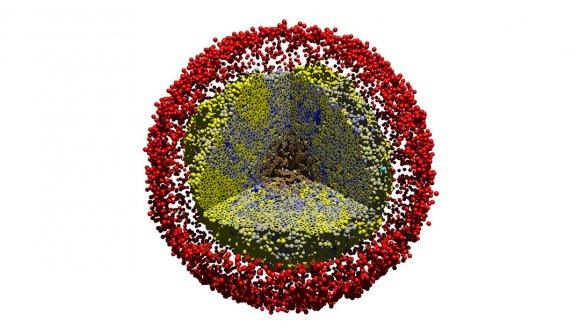A computer modeling system developed by BCRF investigators allows scientists to simulate tumor cell behavior.
In a study published in the journal, PLoS Computational Biology, BCRF investigator Paul Macklin introduced PhysiCell, a tool that allows scientists to build mathematical models of complex multicellular systems, like tumors, and run them on a computer. The paper describes how they have used the model to simulate several biological and biophysical cell processes in the context of cancer.
“Cancer is a complex system,” Dr. Macklin, an Associate Professor of Intelligent Systems Engineering at Indiana University, explained.
“This complex system catches us off guard when it doesn’t do what we expect. Things may work well when we test them under laboratory conditions– in a petri dish– but in the human body, there may be all sorts of surprises: the treatment doesn’t work or causes side effects we didn’t anticipate.”
PhysiCell is designed to study these problems on a computer before new treatments are tested in patients. This revolutionary technology allows scientists to conduct multiple drug screening assays in thousands to millions of cells at once. This lets researchers program different components of the system and see what takes place. This process would take months or even years to do in the lab.
“Early technology development takes a lot of time and very few funders will take that risk,” said Dr. Macklin. “BCRF took a chance on us and what could have been very risky research. We could not have done this without their support.”
Rewriting the script to change how cancer cells behave
To best understand how PhysiCell works, Dr. Macklin invites us to see the cancer environment as a form of theater.
The stage is the chemical environment (sometimes referred as microenvironment) around the tumor. The actors, or players, are the tumor cells that take cues from the stage. The script is the interaction of the stage and the players.
“The cancer has a constant dialogue between the players and the stage,” he said, “constantly resetting the stage. It goes off script, ad-libs and changes the script.”
Our jobs as scientists is to observe the play and describe what happens. The clinicians or engineers rewrite the cancer script and get the players to act differently –to behave like normal cells. PhysiCell allows us to try that in a virtual environment.
Setting the stage to accelerate better treatments
Because the PhysiCell system allows scientists to conduct thousands of virtual experiments almost simultaneously, researchers will be able to design better clinical trials to advance promising drugs to the clinic.
They can determine the right combinations, the right doses and even the best drug delivery strategy before patients are enrolled in clinical trials and reduce the number of unexpected side effects.
“It allows us to identify the most beneficial treatment scenarios by changing parameters in the model that target specific processes one at a time,” Dr. Macklin noted. “That allows us to identify the most efficient treatment strategy or high priority targets for drug development.”
The system is not there yet, however. Now that the main tool is working, Dr. Macklin’s team will test it in studies of breast cancer metastasis in collaboration with BCRF investigators, Dr. Danielle Gilkes and Dr. Andrew Ewald, both at Johns Hopkins University School of Medicine. These projects are supported through a BCRF partnership with The Jayne Koskinas Ted Giovanis Foundation (JKTGF) for Health and Policy Partnership as part of a mathematical oncology initiative.
“We’re getting to a point where we’re starting to model more complicated things, like cancer immunotherapy and immune responses.” Dr. Macklin said. By modeling how immune cells interact with cancer cells, he hopes to identify the best immunotherapy approaches for the greatest effect.
More powerful than the sum of its parts
Another important feature of the system is that it is open source code, meaning that users can customize it and add new functions.
Research teams in the U.S., France and Germany are already beginning to test the system and Dr. Macklin expects usage to grow exponentially as scientists begin to use it to conduct studies they haven’t been able to do in the past.
“By creating an open source program, the technology can expand organically as users create new components to answer their own questions,” said Dr. Macklin.
“If we had to add each new capability on our own, it would take years of research. Our hope is that we not only enable our own research, but that we enable the whole community.”
Read more about Dr. Macklin’s BCRF/JKTGF research with collaborator Daniele Gilkes on our Meet the Researchers page. Also, listen to this interview with Drs. Macklin and Gilkes from our Investigating Breast Cancer podcast series.







